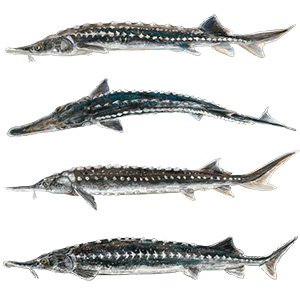GFCM pilot project on the marine life of Black Sea Sturgeons

Sturgeons are among the most iconic of all Black Sea species but also among the most threatened species groups in the basin and in the world. Though fishing for the several species of sturgeon (Acipenseridae) present in the Black Sea basin is no longer permitted, this prohibition alone will not suffice to ensure their survival. Their impressive size and strength cannot protect sturgeons from a variety of threats, including blocked migration routes, pollution, bycatch in commercial fisheries, and illegal, unreported and unregulated fishing.
To support the fish’s recovery, the General Fisheries Commission for the Mediterranean (GFCM) has launched a pilot project to address fisheries-related challenges faced by Black Sea sturgeons.
 Stellate Sturgeon ©GFCM/Ali Elly
Stellate Sturgeon ©GFCM/Ali Elly
Sturgeons migrate long distances between marine water, where they feed and grow, and fresh water, where they breed. The pilot project focuses on the marine part of their life cycle, with the first stages of work having begun a few months ago through awareness-raising campaigns and local ecological knowledge (LEK) studies. As a starting point for the pilot project, an online seminar organized in March brought together 71 sturgeon experts from 10 countries to review the progress so far and create a network for future collaboration.
The pilot project will foster collaboration at the national, international and regional levels
The Working Group on the Black Sea (WGBS) conceived the Black Sea sturgeon pilot project, which is being conducted under the GFCM BlackSea4Fish project, in collaboration with a range of partners. Its focus is on how best to conserve the species at the national, international and regional levels, including through awareness-raising activities and fisher engagement.
.jpg) ©GFCM/Claudia Amico
©GFCM/Claudia Amico
Experts shared their findings from the Black Sea at the seminar
Yunus Emre Fakıoğlu, GFCM Expert in bycatch and gear technology, shared information on the pilot project and its methodology and presented the preliminary findings of a series of LEK studies conducted along the Black Sea coast.
“The marine life of sturgeons has received relatively little attention until now. We’ve usually seen research being done in rivers, but with this pilot project the GFCM is focusing on the critical state of their marine life cycle. Based on the first observations made during the LEK interviews, unfortunately it is not only the sturgeons that are seriously threatened, but also the sources of information. Soon, the information may no longer be available as the younger generation is not taking on fisheries work from the older generations,” said Fakıoğlu.
The seminar featured presentations on sturgeon mapping and monitoring activities in Romania and Bulgaria, while participants from Türkiye and Ukraine discussed their findings on sturgeon bycatch from demersal trawlers and pelagic trawlers, respectively.
 Stellate Sturgeon ©GFCM/Ali Elly
Stellate Sturgeon ©GFCM/Ali Elly
“Before the start of GFCM discards monitoring programme in 2018, there was no reliable information on the scale of sturgeon bycatch from trawlers, and this phenomenon was believed to be very rare. However, in the course of one year of monitoring, we found that sturgeon bycatch in trawlers is observed quite often,” said Sergii Bushuiev, Senior Researcher at the Institute of Marine Biology of the National Academy of Science of Ukraine.
To conclude the seminar, guest speaker Eric Rochard, Senior Researcher at the National Research Institute for Agriculture, Food and the Environment of France, presented a case study from northwestern European waters, focusing on sturgeon distribution and their interactions with fisheries.
Next steps: bringing on board the experience and understanding of Black Sea fishers
Sturgeons have been on the planet for many millions of years, having outlived dinosaurs. But today they are among the most threatened species groups in the world, with 17 of 25 sturgeon species classed as critically endangered by the International Union for Conservation of Nature (IUCN). The GFCM pilot project is therefore contributing to a vitally important initiative that will continue with awareness-raising campaigns and a region-wide dialogue on the critical issues threatening the future of sturgeons. Project partners will work with Black Sea fishers to incorporate their experience and understanding, fill knowledge gaps and inform future management of these critically endangered Black Sea fish. The outcomes of this pilot project will support decision-making at the next session of the GFCM in 2024.
